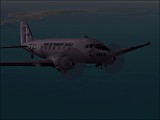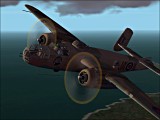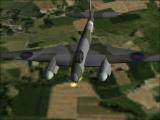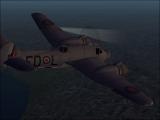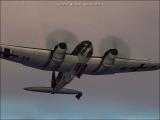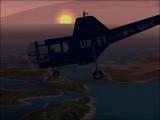Pads's Pad
CFS2 Aircraft
- Douglas R4D-6 NATS
- B-25J RAF Mk III
- DH98 Mosquito
- Bristol Beaufighter TFX
- Heinkel 111H-6
- Sikorsky S-51 Helicopter
The following links are to CFS2 aircraft produced by designers that have particularly captured my imagination and greatly enhanced my enjoyment of CFS2, either because of the impressive nature of their visual implementation, the realism of their flight models and/or because they are just fun to 'fly'!
RCS Panels Douglas R4D-6 NATS v4.0
The R4D-6 Skytrain had its origin as the civilian Douglas DC-3. It was designated the R4D-6 by the US Navy (the USAAF called it the C-47B) and was ordered from Douglas by the USAAF and transferred to the Navy between August 1944 and March 1945. It was in many ways identical to previous versions, although was equipped with two 1,200 hp Pratt & Whitney R-1830-90C engines with two-stage, two-speed superchargers, provisions for fuel tanks in the fuselage and improved heaters. It was intended for high altitude flights over the 'Hump' in the China-Burma-India (CBI) theatre of operations. NATS indicates that the aircraft flew for the Naval Air Transport Service.
The R4D/C47 excelled at transportation, both of cargo (for which read anything that could fit inside it, including vehicles!) and troops. Indeed, Eisenhower considered it the most important weapon of World War 2, acknowledging the importance of need for proper logistical support in wartime conditions. So successful was this aircraft at fulfilling this role that its modern descendants can still be found in operation in many air forces around the world today. (Sources: Jack McKillop & Frans Bonné).
This version of the aircraft was designed and implemented to an extremely professional level by RCS Panels and is based on an extant R4D-6 based at the Mid Atlantic Air Museum, Pennsylvania (see note on MAAM below). It is quite simply one of the most impressively put together aircraft I have ever seen in a flight simulation. Note that although this version of the R4D-6 is intended for FS2000 only, it also seems to fly extremely well in CFS2, too. Indeed, it is a pleasure to fly!
To download the R4D-6, go to the R4D-6 Version 4 STANDALONE FS2000 Only section of the Packages page of the RCS Panels site and download wjrdc3v4a.zip (11MB) and wjrdc3v4b.zip (12MB). The former contains the aircraft files and FS2000 Pilots folder (which can be discarded for CFS2), the latter contains the gauges and a comprehensive HTML manual on flying this aircraft and using its complex panel. It is highly recommended that you read the manual carefully.
I also strongly recommend the use of the panel and sounds for this aircraft in the CFS2 AI flyable C47 Dakota. I have also found that I have better results using the R4d-6 .air file with the AI C47 than when using the widely available AI flyable .air file.
Note: Please read the legal section of the manual relating to the conditions for using this aircraft. This link has been provided with the written permission of Roy Chaffin - it is not otherwise permitted to redistribute the files for this aircraft in any shape or form. Note also that Roy Chaffin and RCS Panels no longer have any association with MAAM, please see the RCS Panels site for details.
Go to the RCS Panels site
RCS Panels B-25J RAF MkIII 'Jaguar's Justice'
However impressive the RCS Panels R4D-6 is, their B-25J RAF MkIII is easily the singularly most detailed, high quality implementation of an aircraft for CFS2 that I have ever seen. The attention to detail lavished on both interior and exterior is breathtaking and it is no surprise that this aircraft took Roy Chaffin and the rest of the RCS Panels team (Steve Wayne, Brian Withers, Alan Landsburgh and Arne Bartels) 12000 man hours to produce!
The B-25J also offers a range of view options from within the cockpit (both VFR and an outstanding IFR version) and includes an excellent working bombsight. It also boasts a highly accurate flight model. Again, this aircraft is a pleasure to fly!
Perhaps unsurprisingly given the very high standards of its implementation, the full self-installing download package for this aircraft weighs in at an impressive 59MB. It can be downloaded directly by following the link below (supplied here by kind permission of Roy Chaffin) or more easily in 13 manageable sections from the Packages section of the RCS Panels site.
It should be noted that no commercial software provider would ever be able to spend the amount of time, resources and energy that are required for a product of this nature and the committedly freeware ethos typified by RCS Panels in producing this aircraft is to be highly commended. With this in mind, please be sure to read the legal notice which can be found in the comprehensive HTML manual supplied with this download package and honour the wishes of the development team regarding your use of their work.
Download B-25J RAF directly (59MB)
Gryphon DH 98 Mosquito Pack
The de Havilland Mosquito (the Wooden Wonder or Flying Matchbox) was an extremely versatile twin-engined fighter bomber built almost entirely from wood (the wings had plywood skins and the fuselage was constructed from a sandwich of balsa between plywood skins built on spruce stringers)! This construction technique made for a relatively lightweight aircraft which, powered by twin Merlin engines, was capable of speeds up to 400mph! It also packed an impressive punch in the form of 4 20mm cannon mounted in the nose as well as providing scope for a range of bomb loads (including Barnes Wallis's 'High Ball' bouncing bomb, a smaller version of the famous 'Upkeep' bomb used in the Dambuster's raid.)
The Mosquito served the Allies in many capacities during the Second World War: photo-reconaissance, bomber, fighter-bomber, night-fighter, pathfinder, torpedo-bomber, U-boat killer, to name but a few its many roles. Of all the British aircraft of this period, it has consistently continued to inspire affection and capture the imagination in a way surpassed perhaps only by the Spitfire.
This version for CFS2 is provided by Gryphon Aviation (Steve Downing, Marv Howell, David Payne, Richard Charlebois, and Hugh Shoults) and comes with multiple levels of detail (LOD), 1% airfile by Jerry Beckwith, working (frame-rate friendly) virtual cockpit views and the Gryphon bombsight. It is an outstanding aircraft which I cannot recommend enough! It comes in three versions: Mk.II Night Fighter, Mk.IV Bomber, and Mk.VI Fighter Bomber.
Download from the Gryphon web site
AvHistory 1% Bristol Beaufighter TFX
The Bristol Beaufighter became fully operational in late 1940 when it functioned predominantly as a night-fighter equipped with the then new AI (airborne interception) radar. This was a role at which it was to excel throughout the war as night-fighting tactics were developed and further technological breakthroughs were made in the field of in-aircraft radar.
The Beaufighter was both fast and deadly, carrying an armament of four 20mm Hispano cannons in the nose and six .303 Browning machine guns in the wings and capable of speeds of up to 320mph. Later in the war, the Beaufigher also saw action as a torpedo bomber in the North Sea (first sinking two supply ships off the coast of Norway in April, 1943) and served extensively in the war with Japan in India for the RAF and with the RAAF in the south-west Pacific.
This CFS2 version of the aircraft comes from the '1% aircraft' specialists at AvHistory.org. 1% aircraft are designed by a process of painstaking research and careful development to produce aircraft that perform within 1% of their real-world counterparts.
As well as having a very high fidelity flight model, this particular aircraft is also rendered particularly well visually. It is a delight to fly and is surprisingly manoeuverable! It comes in two versions (Torpedo and non-Torpedo) with associated panels, damage profiles, and 7 different texture files. It also has full virtual cockpit views.
The Beaufighter TFX is available from the CFS2 1% Downloads > WW2 Fighters > Britain section of the AvHistory web site.
Download from AvHistory.org
Ground Crew Design Group Heinkel 111H-6
Originally designed as a ten-passenger transport plane, the HE-111 was delivered as a medium bomber to the Luftwaffe in late 1936. Converted for military use, it first served the Luftwaffe as a medium bomber during the Spanish Civil War in 1937.
During the Battle of Britain in 1940, the H-111 proved under-armed and lacking performance in both altitude and speed and was eventually withdrawn from daylight bombing in October 1940. However, it continued to be used on night bombing missions, participating for example in the Blitz on London and other civilian and industrial centres in Britain, and flew with the Luftwaffe until the end of the war.
The Ground Crew Design Group's version of this aircraft for CFS2 is a representation of a He111H-6 flown by Stab I./KG 26 in France during Summer 1942 (for full credits, see the Ground Crew link below). It is impressively implemented in Gmax and uses a frame rate friendly level of detail (LOD). It has an impressive range of weapons loadouts (care of the Ground Crew German weapons pack) and comes with a highly detailed 2-d panel and virtual cockpit. It also has working bomb bay doors (activated by the '/' key - see the image above). Go against this aircraft in Quick Combat and decide for yourself how 'under-armed' it is...
A full 50-mission campaign centred around the He111 by Cliff Burgess and the Ground Crew team is available from the CFS2 Packages section of the site, along with a range of other excellent campaigns based in various European theatres of operation during World War II.
Download from Ground Crew Design Group
Sikorsky S-51 Helicopter
The Sikorsky S-51 was the first commercial helicopter and first flew in 1946 (prototype versions were flying as early as 1943!). It was taken up by the military as the H-5 Dragon Fly in 1947 and saw active service in Korea. Its predominant role was in the air evacuation of combat casualties and search and rescue of downed pilots, often behind enemy lines. Production of the S-51 ceased in 1951 and it was phased out of US military service in 1952.
This CFS2 version by Ignacio Alfredo Mendive is both visually appealing and a delight to fly. Although it is capable of slightly higher speeds than its real-life counterpart, it is also surprisingly easy to manoeuvre and land (even at hard settings!).
This aircraft also has a highly usable, frame-rate friendly virtual cockpit with working gauges. A 2-D cockpit designed to complement the virtual cockpit will be available at this site shortly (see Panels). Note that this download has no sound folder. I recommend using the CFS2 helicopter package available at Simviation CFS2 Utilities to provide access to the required sound files.
Download from Simviation
